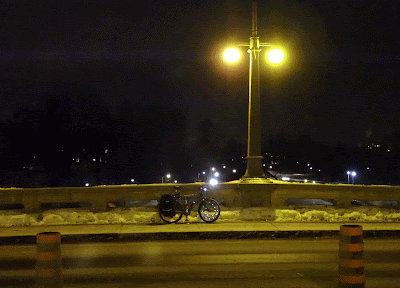On October 1 of this year, while attending a drop-in Open House about the City of Ottawa's plans to rehabilitate the Booth Street heritage bridge (more on that to come in a future blog post), a City representative mentioned offhandedly that the Fleet Street water pumping station had been converted to electric pumps "decades ago", like in the 1950s.
One of the LeBreton Flats residents in attendance, echoing the sentiment of many, expressed dismay that he'd been telling people for years that it was a water-powered water pumping station. I, myself, had made this claim in my 2012 blog post 3D Through the Aqueduct (part 2).
While still at the Open House, I did a quick Google search on my phone, and found only unsubstantiated claims. A City employee working on a project about one of the aqueduct's bridges is a pretty compelling authority. My next step was to send out a Tweet calling on the crowdsourcing power of Twitter to confirm or deny these electric claims.
One piece of 'new' information supplied by Ian Izzard of the City: the Fleet St Pumping station has been fully electric powered (not hydraulic from aqueduct) since the 1950s. Can anyone confirm this? @HeritageOttawa #ottcity #LeBretonFlats
— Charles A-M (@Centretowner) October 1, 2019
That yielded nothing conclusive. There was a City report describing the pumping station as water-powered, but that report was prepared by the Councillor's office, not the water department.
I eventually (Oct 17) emailed Councillor McKenney, who sent the request down the bureaucratic ladder, and the very next day I got this wonderfully clear and detailed response from Paul Montgomery of the City's water department. (Emphasis added, slightly edited).
Mr. Akben-Marchand,
There are five water turbine powered centrifugal pumps at the Fleet Street pumping station; all are still used and in service. A small amount of electrical power is required, for automated controls, lighting and such, but the primary sources of motive power for the station's installed pumps is water and, of course, gravity.
Many people incorrectly assume that we use the river, at Fleet Street, to drive generators which would then drive electric motors and, in turn, to drive pumps. Rather, we use water powered turbines to drive mechanical gear boxes / speed increases to then directly drive the installed pumps.
Approximately 20m3/s of Ottawa River water flows, through a headworks control gate structure located along the shore of Nepean Bay, through the covered Aqueduct below the former Ottawa Street, to the Fleet Street Pumping Station and then down through the turbines. The approximate head, across the turbines, is 27 feet.
Treated drinking water flows by gravity, through a large buried watermain from the Lemieux Island Water Treatment Plant, to supply the five pumps at Fleet. At full capacity, the Fleet Street pumping station can supply approximately 200ML/day to the City.
Thanks,
M. Paul Montgomery, P. Eng.
Plant Manager, Water Production - East
Water Services, PWES
That settles that! I publish it here for posterity, and for the next person who hears rumours of the plant's electrification!
By the way, that "200ML/day" refers to Megalitres per day, or 200,000,000 litres! I discussed the underground Ottawa Street aqueduct in this 2012 blog post.
LeBreton Flats updates/errata
On the topic of corrections and updates, here are some to some previous blog posts about LeBreton Flats:
- In the 2012 post, 3D Thursday: 3D through the aqueduct, part 2 of 2, I didn't know the purpose of the wooden bracing on the Fleet Street Pumping Station building. A CBC Ottawa News video from 2013 says that the City was doing repairs to cracks that developed on both the pumping station and Pooley's Bridge following blasting at the site of nearby condo development on Lett Street.
- The tree featured in the 2014 post, The Lonely Elm was cut down in Winter 2014-2015 (literally: the two nearest photos showing the tree present and absent were on 2014-12-21 and 2015-03-28). The price of progress for LRT and, it would seem from aerial photos, the Combined Sewage Storage Tunnel (CSST) access shaft.
- Also in the Lonely Tree post, I referred to a section of Wellington Street as "Old Wellington", which was incorrect. It would have just been "Wellington".
I actually have a number of LeBreton Flats related blog posts in various stages of development that I hope to publish soon, including the results of quite a bit of research about Wellington Streets.
[Look for more one-photo posts under the label Singles]




















